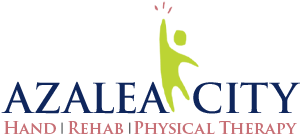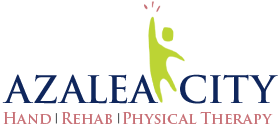Rotator Cuff Impingement in Mobile AL

Rotator cuff impingement in Mobile AL is one of those nagging shoulder issues that can stop you from enjoying life's simple pleasures-whether it's reaching for something on a shelf or hitting the gym. The discomfort or pain caused by this condition can make even the most basic movements feel like a challenge. However, with the right treatment plan, specifically tailored physical therapy/occupational therapy you can regain full shoulder function and prevent long-term damage.
Azalea City Hand and Rehab and Physical Therapy can take you on a dive deep into what rotator cuff impingement is, what causes it, its symptoms, and how physical therapy/occupational therapy can play a pivotal role in your recovery.
What Is Rotator Cuff Impingement in Mobile AL?
Rotator cuff impingement, also known as shoulder impingement syndrome, occurs when the tendons of the rotator cuff become compressed between the bones in your shoulder. The rotator cuff is a group of muscles and tendons that stabilize your shoulder and allow you to move your arm in various directions.
When the space in your shoulder joint becomes too narrow-due to inflammation, bone spurs, or poor posture-the rotator cuff tendons get pinched or "impinged." This can lead to pain, inflammation, and even tendon damage if left untreated. Rotator cuff impingement is a common condition, especially among athletes and individuals who frequently lift their arms overhead.
Symptoms of Rotator Cuff Impingement In Mobile AL
If you're experiencing rotator cuff impingement, you'll likely notice several symptoms, many of which can make daily tasks uncomfortable or even painful. Here are the key symptoms to watch for:
- Shoulder Pain with Overhead Movements: The most common symptom of rotator cuff impingement is pain when lifting your arm overhead or reaching behind your back. This pain is often localized on the front or side of your shoulder.
- Difficulty Lifting or Lowering the Arm: You may feel weakness or discomfort when trying to raise or lower your arm, especially during activities like reaching up to grab something or putting on a jacket.
- Pain at Night: Many people with impingement syndrome experience increased pain when lying on the affected shoulder at night, which can disrupt sleep.
- Limited Range of Motion: Stiffness in the shoulder joint can make it difficult to perform simple tasks, such as brushing your hair or reaching behind your back.
- Tenderness and Swelling: You might notice tenderness or swelling around the front of your shoulder, especially when pressing on the area.
- Clicking or Popping: Some individuals report hearing a clicking or popping sound when moving their shoulder, which can be a sign of tendon irritation.
These symptoms can range from mild discomfort to severe pain, depending on the extent of the impingement and whether there's any associated tendon damage.
What Causes Rotator Cuff Impingement?
There are several factors that can contribute to rotator cuff impingement, many of which involve repetitive movements or poor shoulder mechanics. Here are the most common causes:
- Repetitive Overhead Movements
One of the primary causes of rotator cuff impingement is repetitive overhead activities, which place strain on the tendons and muscles in the shoulder. Sports like swimming, baseball, and tennis, as well as occupations such as painting or construction, can lead to impingement due to the frequent use of overhead motions. - Poor Posture
Poor posture, particularly slouching or rounded shoulders, can reduce the space in the shoulder joint, increasing the likelihood of tendon impingement. When the shoulder blades are not properly aligned, they can press on the rotator cuff tendons, causing irritation and inflammation. - Bone Spurs
Bone spurs, or bony growths that form on the shoulder joint, can narrow the space available for the rotator cuff tendons. As these spurs press against the tendons, they can cause impingement and pain. - Aging and Wear and Tear
As we age, the tendons in the rotator cuff naturally degenerate, making them more prone to injury. The wear and tear that comes with aging can lead to thinning of the tendons, increasing the risk of impingement, especially for individuals who remain active in sports or physical work. - Shoulder Injuries
Previous shoulder injuries, such as a rotator cuff tear or shoulder dislocation, can weaken the tendons and lead to impingement over time. Scar tissue or muscle imbalances resulting from the injury can also contribute to narrowing the space in the joint.
How Is Rotator Cuff Impingement Diagnosed?
If you're experiencing shoulder pain and suspect it might be rotator cuff impingement, it's essential to seek a proper diagnosis from a healthcare professional. Here's what you can expect during the diagnostic process:
1. Physical Examination
Your healthcare provider or physical therapist will start with a thorough examination of your shoulder, assessing your range of motion, strength, and any areas of tenderness. They may ask you to perform specific movements, such as raising your arm or reaching behind your back, to pinpoint the location and severity of the pain.
2. Impingement Tests
Several clinical tests are commonly used to diagnose rotator cuff impingement. These tests involve specific arm movements that compress the rotator cuff tendons to determine if impingement is present. The Neer test and Hawkins-Kennedy test are two common assessments that help identify impingement.
3. Imaging Tests
In some cases, your healthcare provider may recommend imaging tests to get a clearer view of the shoulder structures. These tests may include:
- X-rays: While X-rays can't show soft tissue damage, they can reveal bone spurs or other structural issues contributing to impingement.
- MRI: An MRI can provide detailed images of the rotator cuff tendons, revealing inflammation, tears, or other abnormalities.
- Ultrasound: Ultrasound imaging can be used to assess the movement of the rotator cuff tendons in real time, helping to confirm a diagnosis of impingement.
How Physical Therapy/Occupational Therapy Helps People with Rotator Cuff Impingement
Physical therapy/occupational therapy is one of the most effective treatments for rotator cuff impingement. It focuses on reducing pain, restoring mobility, and strengthening the shoulder to prevent future injuries. Here's how physical therapy/occupational therapy can help:
- Reducing Pain and Inflammation
The initial goal of physical therapy/occupational therapy is to manage pain and reduce inflammation in the affected tendons. This is achieved through various methods, including:- Manual Therapy: Hands-on techniques such as soft tissue mobilization and joint mobilization help improve circulation, reduce stiffness, and alleviate pain in the shoulder joint.
- Cold Therapy: Applying ice packs or cold compresses can help reduce swelling and numb the pain.
- Ultrasound Therapy: Ultrasound therapy may be used to promote healing by improving blood flow to the injured tendons and muscles.
- Improving Shoulder Mobility
Rotator cuff impingement often leads to limited range of motion in the shoulder joint. Your physical therapist will guide you through a series of exercises designed to restore mobility and flexibility, such as:- Gentle Stretching: Stretching exercises focus on lengthening the muscles and tendons around the shoulder to improve flexibility and reduce stiffness.
- Joint Mobilization: Techniques to mobilize the shoulder joint can help restore full range of motion and reduce impingement.
- Strengthening the Rotator Cuff Muscles
Strengthening the muscles around the shoulder is key to supporting the rotator cuff and preventing future impingement. Your physical therapist will introduce exercises that target the rotator cuff and surrounding muscles:- Resistance Training: Using resistance bands or light weights, your therapist will guide you through exercises that build strength in the rotator cuff muscles.
- Scapular Stabilization Exercises: Strengthening the muscles that stabilize your shoulder blade is essential for proper shoulder mechanics and reducing strain on the rotator cuff tendons.
- Correcting Posture and Movement Patterns
Poor posture is a significant contributor to rotator cuff impingement. Your therapist will assess your posture and provide guidance on how to maintain proper alignment throughout the day:- Postural Retraining: Your therapist will teach you how to adjust your posture, especially when sitting, standing, or performing overhead activities.
- Ergonomic Adjustments: If you spend long hours at a desk or perform repetitive motions at work, your therapist may recommend ergonomic changes to reduce strain on your shoulder.
- Preventing Future Injuries
Physical therapy/occupational therapy not only helps you recover from current symptoms but also provides you with tools to prevent future injuries. Your therapist will create a personalized home exercise program to continue building strength and flexibility after therapy ends. By staying active and maintaining good posture, you can reduce the risk of re-injury.
What Should You Do If You Think You Have Rotator Cuff Impingement?
If you suspect you have rotator cuff impingement, it's important to take action early to prevent the condition from worsening. Here's what you should do:
- Rest and Avoid Aggravating Activities: Give your shoulder a break from activities that require repetitive overhead motions, such as lifting or throwing.
- Apply Ice: Use an ice pack to reduce inflammation and alleviate pain, especially after activities that irritate the shoulder.
- Seek Physical Therapy/Occupational Therapy: Early intervention with physical therapy/occupational therapy can speed up your recovery and prevent long-term damage. A physical therapist can assess your condition and create a personalized treatment plan to address your specific needs.
- Modify Your Movements: Be mindful of your movements, particularly those involving overhead activities. If certain motions are causing pain or discomfort, it's essential to modify or avoid them until your shoulder has healed. Your physical therapist can guide you on how to perform tasks in a way that minimizes strain on the rotator cuff.
- Stay Consistent with Exercises: If your physical therapist gives you exercises to do at home, consistency is key. These exercises are designed to strengthen your shoulder, improve flexibility, and promote long-term recovery. Stick with your exercise routine to avoid further complications.
Get Back To Living With Physical Therapy/Occupational Therapy
Rotator cuff impingement doesn't have to limit your lifestyle or cause long-term discomfort. With early diagnosis and the right approach through physical therapy/occupational therapy, you can reduce pain, restore mobility, and prevent future shoulder injuries. Physical therapy/occupational therapy offers a non-invasive and highly effective solution to help you regain full shoulder function and get back to doing the things you love-pain-free.
If you're experiencing shoulder pain in Mobile AL or suspect you have rotator cuff impingement, don't wait. Schedule an appointment with a physical therapist at Azalea City Hand and Rehab and Physical Therapy today and start your journey to recovery. With the right guidance and treatment plan, you'll be on your way to stronger, healthier shoulders.
OFFICE HOURS
Monday
8:00am - 5:00pm
Tuesday
8:00am - 5:00pm
Wednesday
8:00am - 5:00pm
Thursday
8:00am - 5:00pm
Friday
8:00am - 12:00pm
Saturday & Sunday
Closed
Azalea City Hand and Rehab and Physical Therapy
316 S Sage Ave Ste C
Mobile, AL 36606


